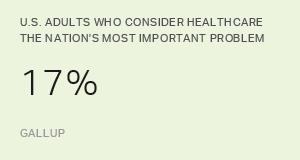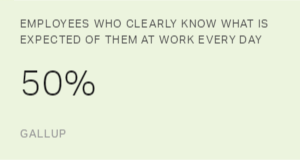Story Highlights
- With forward-thinking strategies, leaders can outsmart industry challenges
- Leaders need to predict what matters using the right analytics
- Prioritizing employee engagement is paramount for optimizing outcomes
When Gallup asked U.S. adults about the "most important problem" facing the country, two issues topped their list of concerns: government/poor leadership and healthcare.
Nearly one-fifth (17%) of U.S. adults feel that healthcare is America's greatest problem.
Fixing healthcare in the U.S. requires, among many other things, forward-thinking leadership. However, five healthcare megatrends (defined as larger, disruptive forces in an industry) complicate the job of leading in an uncertain healthcare environment.
- The chronically sick: Diabetes is an epidemic that must be addressed.
- Demographic realities: An aging population and millennials are disrupting healthcare.
- Digitization of everything: Leaders need to harness the full predictive potential of big data and analytics.
- Technological and biological fusion: Emerging technologies show promise for improving patient care.
- Workforce disruptions: Relentless industry changes and M&A are taxing employee engagement.
Fortunately, these five forces also present promising opportunities for healthcare leaders to improve patient, employee and business outcomes.
Advice for Healthcare Leaders:
1. Build your analytics platform today.
Healthcare companies should start developing their comprehensive analytics solutions now, because cost-cutting analytics systems aren't born overnight.
With endless quantities of healthcare data, leaders need to carefully select an analytics partner that will enable them to predict what matters for improved patient and business outcomes.
2. Accelerate M&A integration.
Gallup finds that cultural mismatch is one of the most common causes of M&A failure.
To promote M&A success, leaders should focus on building integrated, unified work cultures. Innately talented managers and solid communication plans are two essential ingredients in this endeavor.
3. Find forward-thinking builders and leaders.
More than ever, healthcare companies need exceedingly talented leaders who understand industry demands and inspire excellence in the midst of change.
For example, delivering consumer-oriented care and tackling population health management are unique responsibilities that will fall on future leaders' shoulders.
Companies should use data-driven attraction methods, hire based on innate talent and invest in leaders' ongoing development.
4. Get better at leading change.
For healthcare leaders, change is the name of the game.
Gallup's work with the most engaged healthcare organizations reveals four organizational strengths that enable them to weather industry changes:
- clear and open communication across the organization
- a well-articulated mission and purpose that is consistent with the organization's culture
- a commitment from leadership to create a positive work environment
- a strong commitment to the community
By honing their change leadership skills, healthcare leaders can build work cultures that endure change and consistently outperform peers in patient satisfaction and financial returns.
5. Measure, monitor and improve relationships with suppliers, customers and patients.
During times of change, relationships are of paramount importance.
For healthcare leaders, proven metrics -- on everything from patient wait times to market share to productivity -- are the key to understanding and optimizing relationships.
With these data, healthcare leaders can build engaging, profitable, long-lasting relationships with consumers and suppliers.
Gallup's in-depth analyses on each of the five healthcare megatrends illustrate transformative insights for leaders. Here's what our research reveals:
The Chronically Sick
Diabetes in America is getting worse, not better.
According to the Gallup-Sharecare Well-Being Index, the overall prevalence of diabetes in the U.S. is 12% in 2016, compared with 11% in 2008.
The numbers are even grimmer when you look at diabetes prevalence among seniors (24%), blacks (15%), people with a high school education or less (14%), and people who earn less than $24,000 per year (19%).
Geographically, the South struggles most with diabetes. More than 14% of populations in Alabama, West Virginia, Mississippi, Tennessee, South Carolina and Arkansas have been diagnosed with diabetes.
Diabetes is an epidemic and a population health nightmare. The American Diabetes Association estimates that people living with diabetes have healthcare costs that are 2.3 times greater than people without diabetes.
Forward-thinking healthcare leaders must devise strategies for mitigating this problem before it bankrupts companies and the nation.
This will require greater transparency, collaboration, incentives and public-private programs that focus on behavioral transformation, education and nutrition.
Demographic Realities
Americans are getting older and living longer. At the same time, millennials are waiting longer to get married and have children. This is a recipe for a rapidly aging population, as the proportion of older U.S. adults dramatically increases.
According to the U.S. Census Bureau, the total U.S. population aged 65 and older will reach 83.7 million in 2050 -- almost double the 2012 figure of 43.1 million.
To make matters worse, America is running out of nurses.
Though the nursing field is one of the fastest growing occupations in the country, demand is dramatically outpacing supply. The national nursing shortage -- already a daunting problem -- will only intensify as the population ages.
To confront and overcome the complexities of the nursing shortage, hospitals must use an innovative, multi-level approach:
- recruiting new nurses to the profession
- hiring nurses for talent while training them for skills
- creating an environment in which nurses thrive and want to stay
The rise of millennials represents another demographic challenge on the horizon for healthcare leaders.
Though millennials are relatively young and healthy now, the generation's vast size, racial and ethnic diversity, and unique consumer demands position it to dramatically reshape healthcare.
Millennials select and interact with healthcare providers differently than older generations.
For example, millennials value online provider reviews far more than other generations. Care affordability is a major concern among millennials, with 18% reporting they could not afford healthcare in the last 12 months.
Millennials also place greater emphasis on technological innovation, fast care, telemedicine and consumer-oriented service, according to a 2017 study.
To best serve this cohort's unique needs, healthcare leaders should consider evolving their delivery models, branding strategies and communication tactics.
Digitization of Everything
According to a recent report by PwC Health Research Institute, 90% of hospitals now have at least basic electronic health records systems. This is an impressive number, considering that in 2007 only about 9% of hospitals had EHRs.
This trend leaves forward-thinking healthcare leaders pondering questions such as:
- How can we best leverage this wealth of data?
- What data should we feed these systems?
- How should data be entered to avoid disrupting and distracting care providers?
- How should leaders make sense of data to help people improve their health and quality of life?
Adding fuel to the fire is the increased availability and affordability of wearable and implantable technologies that can monitor, measure and warn patients and care providers about healthcare risks.
Even the most commonplace wearable health devices (e.g., Apple Watch and Fitbit) have positive health benefits, such as advising wearers to increase activity.
According to Fitbit's 2016 full-year financial summary, as of Dec. 31, 2016, there were 50.2 million registered Fitbit users.
As of Aug. 2, Fitbit reported selling an additional 6.3 million devices in the first six months of 2017. This equates to a healthcare data mine: Fitbit's millions of users produce exorbitant quantities of health-related data.
Healthcare companies must determine how to use these data to further goals such as patient education.
They should also consider how wearable medical technology can help patients take control of their health and well-being.
Technological and Biological Fusion
Healthcare leaders who are focused on the future are taking notice of new opportunities to reduce cost, improve quality and enhance patients' quality of life.
One such technology is 3-D printing or additive manufacturing.
According to the U.S. Food and Drug Administration, 3-D printing has medical applications in orthopedics (think knee and hip replacements), cranial and spinal implants, surgical instruments and dental restorations.
Given the aging population in America, additive manufacturing is predicted to be a growth market due to baby boomers, whose life expectancy and active lifestyles might contribute to delayed retirement.
And if that's not too futuristic for you, additive manufacturing goes beyond 3-D printing with metal and plastics.
Although in its infancy, bioprinting human tissues for research and reconstructive purposes is possible.
This emerging technology is attracting the attention of investors and grant agencies who see incredible possibilities for human biological advancement.
Workforce Disruptions
The Affordable Care Act (ACA) has sparked many changes in healthcare, with 2015 recording the highest number of healthcare-related M&A deals in recent history.
On top of that, the digitization of the workplace poses challenges for healthcare organizations.
With such disruptions, the industry will undoubtedly undergo extensive transformation in the years ahead.
Gallup finds that the rapid changes in the healthcare industry have adversely affected two critical items of employee engagement: knowing work expectations and connecting with the company's mission.
Unfortunately, these two items have shown a steady decline across a number of healthcare organizations.
To make matters worse, M&A can produce cultural challenges that disconnect employees from the company's mission -- and, in turn, preclude employees from delivering exceptional patient experiences.
Amid unrelenting changes, healthcare leaders must focus on meeting employees' basic needs and developing a culture of engagement.
Clarifying employees' expectations -- while connecting changes with the organization's mission -- can improve employee engagement and employees' confidence in a company's future.
- Download our free B2B report to learn how to build lasting supplier and customer relationships.
- Get better data analysis to make better decisions and grow your business.
- Watch our free webinar, 5 Essential Strategies For Accelerating Change in Healthcare Organizations.
Bailey Nelson contributed to the writing of this article.



